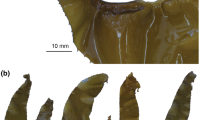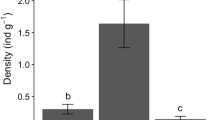Abstract
Many small marine herbivores utilize specific algal hosts, but the ultimate factors that shape host selection are not well understood. For example, the use of particular microhabitats within algal hosts and the functional role of these microhabitats have received little attention, especially in large algae such as kelps. We studied microhabitat use of the herbivorous amphipod Peramphithoe femorata that inhabits nest-like domiciles on the blades of giant kelp Macrocystis pyrifera. The vertical position of nest-bearing blades along the stipe of the algal thallus and the position of the nests within the lateral blades of M. pyrifera were surveyed in two kelp forests in northern-central Chile. Additionally, we conducted laboratory and field experiments to unravel the mechanisms driving the observed distributions. Peramphithoe femorata nests were predominantly built on the distal blade tips in apical sections of the stipes. Within-blade and within-stipe feeding preferences of P. femorata did not explain the amphipod distribution. Amphipods did not consistently select distal over proximal blade sections in habitat choice experiments. Mortality of tethered amphipods without nests was higher at the seafloor than at the sea surface in the field. Nests mitigated mortality of tethered amphipods, especially at the seafloor. Thus, protective microhabitats within thalli of large kelp species can substantially enhance survival of small marine herbivores. Our results suggest that differential survival from predation might be more important than food preferences in determining the microhabitat distribution of these herbivores.






Similar content being viewed by others
References
Allen JD, McAlister JS (2007) Testing rates of planktonic versus benthic predation in the field. J Exp Mar Biol Ecol 347:77–87
Ambrose WG, Irlandi EA (1992) Height of attachment on seagrass leads to trade-off between growth and survival in the bay scallop Argopecten irradians. Mar Ecol Prog Ser 90:45–51
Buschmann AH (1990) Intertidal macroalgae as refuge and food for Amphipoda in central Chile. Aquat Bot 36:237–245
Cerda O, Karsten U, Rothäusler E, Tala F, Thiel M (2009) Compensatory growth of the kelp Macrocystis integrifolia (Phaeophyceae, Laminariales) against grazing of Peramphithoe femorata (Amphipoda, Ampithoidae) in northern-central Chile. J Exp Mar Biol Ecol 377:61–67
Cerda O, Hinojosa IA, Thiel M (2010) Nest-building behavior by the amphipod Peramphithoe femorata (Krøyer) on the kelp Macrocystis pyrifera (Linnaeus) C. Agardh from northern-central Chile. Biol Bull 218:248–258
Coyer JA (1984) The invertebrate assemblage associated with the giant kelp, Macrocystis pyrifera, at Santa Catalina Island, California: a general description with emphasis on amphipods, copepods, mysids, and shrimps. Fish Bull 82:55–66
Cronin G, Hay ME (1996) Within-plant variation in seaweed palatability and chemical defenses: optimal defense theory versus the growth-differentiation balance hypothesis. Oecologia 105:361–368
Damman H (1987) Leaf quality and enemy avoidance in the larvae of a pyralid moth. Ecology 68:88–97
Duffy JE, Hay ME (1991) Food and shelter as determinants of food choice by an herbivorous marine amphipod. Ecology 72:1286–1298
Hay ME, Duffy JE, Fenical W, Gustafson K (1988) Chemical defense in the seaweed Dictyopteris delicatula: differential effects against reef fishes and amphipods. Mar Ecol Prog Ser 48:185–192
Hay ME, Pawlik JR, Duffy JE, Fenical W (1989) Seaweed-herbivore-predator interactions: host-plant specialization reduces predation on small herbivores. Oecologia 81:418–427
Holmes SJ (1901) Observations on the habits and natural history of Amphithoe longimana Smith. Biol Bull 2:165–193
Honkanen T, Jormalainen V, Hemmi A, Mäkinen A, Heikkilä N (2002) Feeding and growth of the isopod Idotea baltica on the brown alga Fucus vesiculosus: roles of inter-population and within-plant variation in plant quality. Écoscience 9:332–338
Long JD, Trussell GC (2007) Geographic variation in seaweed induced responses to herbivory. Mar Ecol Prog Ser 333:75–80
McDonald PS, Bingham BL (2010) Comparing macroalgal food and habitat choice in sympatric, tube-building amphipods, Ampithoe lacertosa and Peramphithoe humeralis. Mar Biol 157:1513–1524
Merilaita S, Jormalainen V (1997) Evolution of sex differences in microhabitat choice and colour polymorphism in Idotea baltica. Anim Behav 54:769–778
Merilaita S, Jormalainen V (2000) Different roles of feeding and protection in diel microhabitat choice of sexes in Idotea baltica. Oecologia 122:445–451
Nelson WG (1979) Experimental studies of selective predation on amphipods: consequences for amphipod distribution and abundance. J Exp Mar Biol Ecol 38:225–245
Núñez LN, Vásquez JA (1987) Observaciones tróficas y de distribucíon especial de peces asociados a un bosque submareal de Lessonia trabeculata. Estud Oceanol (Chile) 6:79–85
Palma ÁT, Ojeda FP (2002) Abundance, distribution and feeding patterns of a temperate reef fish in subtidal environments of the Chilean coast: the importance of understory turf. Rev Chil Hist Nat 75:189–200
Pansch C, Gómez I, Rothäusler E, Veliz K, Thiel M (2008) Species-specific defense strategies of vegetative versus reproductive blades of the Pacific kelps Lessonia nigrescens and Macrocystis integrifolia. Mar Biol 155:51–62
Pérez-Matus A, Shima JS (2010) Density- and trait-mediated effects of fish predators on amphipod grazers: potential indirect benefits for the giant kelp Macrocystis pyrifera. Mar Ecol Prog Ser 417:151–158
Pohle DG, Bricelj VM, García-Esquivel Z (1991) The eelgrass canopy: an above-bottom refuge from benthic predators for juvenile bay scallops Argopecten irradians. Mar Ecol Prog Ser 74:47–59
Poore AGB (1994) Selective herbivory by amphipods inhabiting the brown alga Zonaria angustata. Mar Ecol Prog Ser 107:113–123
Poore AGB, Steinberg PD (1999) Preference-performance relationships and effects of host plant choice in an herbivorous marine amphipod. Ecol Monogr 69:443–464
Rothäusler E, Gómez I, Hinojosa IA, Karsten U, Tala F, Thiel M (2009) Effect of temperature and grazing on growth and reproduction of floating Macrocystis spp (Phaeophyceae) along a latitudinal gradient. J Phycol 45:547–559
Salemaa H (1987) Herbivory and microhabitat preferences of Idotea spp (Isopoda) in the northern Baltic Sea. Ophelia 27:1–15
Sokal RR, Rohlf FJ (1969) Biometry. Freeman and Company, San Francisco, USA
Sotka EE (2007) Restricted host use by the herbivorous amphipod Peramphithoe tea is motivated by food quality and abiotic refuge. Mar Biol 151:1831–1838
Sotka EE, Hay ME (2002) Geographic variation among herbivore populations in tolerance for a chemically rich seaweed. Ecology 83:2721–2735
Sotka EE, Hay ME, Thomas JD (1999) Host-plant specialization by a non-herbivorous amphipod: advantages for the amphipod and costs for the seaweed. Oecologia 118:471–482
Sotka EE, Wares JP, Hay ME (2003) Geographic and genetic variation in feeding preference for chemically defended seaweeds. Evolution 57:2262–2276
Vesakoski O, Boström C, Ramsay T, Jormalainen V (2008) Sexual and local divergence in host exploitation in the marine herbivore Idotea baltica (Isopoda). J Exp Mar Biol Ecol 367:118–126
Warren JH (1985) Climbing as an avoidance behavior in the salt marsh periwinkle, Littorina irrorata (Say). J Exp Mar Biol Ecol 89:11–28
Wheeler PA, North WJ (1981) Nitrogen supply, tissue composition and frond growth rates for Macrocystis pyrifera off the coast of southern California. Mar Biol 64:59–69
Acknowledgments
We are once more very thankful to Carolina and Pedro Correa for their hospitality during our stay in Los Vilos. This study was financed through FONDECYT 1060127 and 7070121.
Author information
Authors and Affiliations
Corresponding author
Additional information
Communicated by F. Bulleri.
Rights and permissions
About this article
Cite this article
Gutow, L., Long, J.D., Cerda, O. et al. Herbivorous amphipods inhabit protective microhabitats within thalli of giant kelp Macrocystis pyrifera . Mar Biol 159, 141–149 (2012). https://doi.org/10.1007/s00227-011-1794-4
Received:
Accepted:
Published:
Issue Date:
DOI: https://doi.org/10.1007/s00227-011-1794-4




